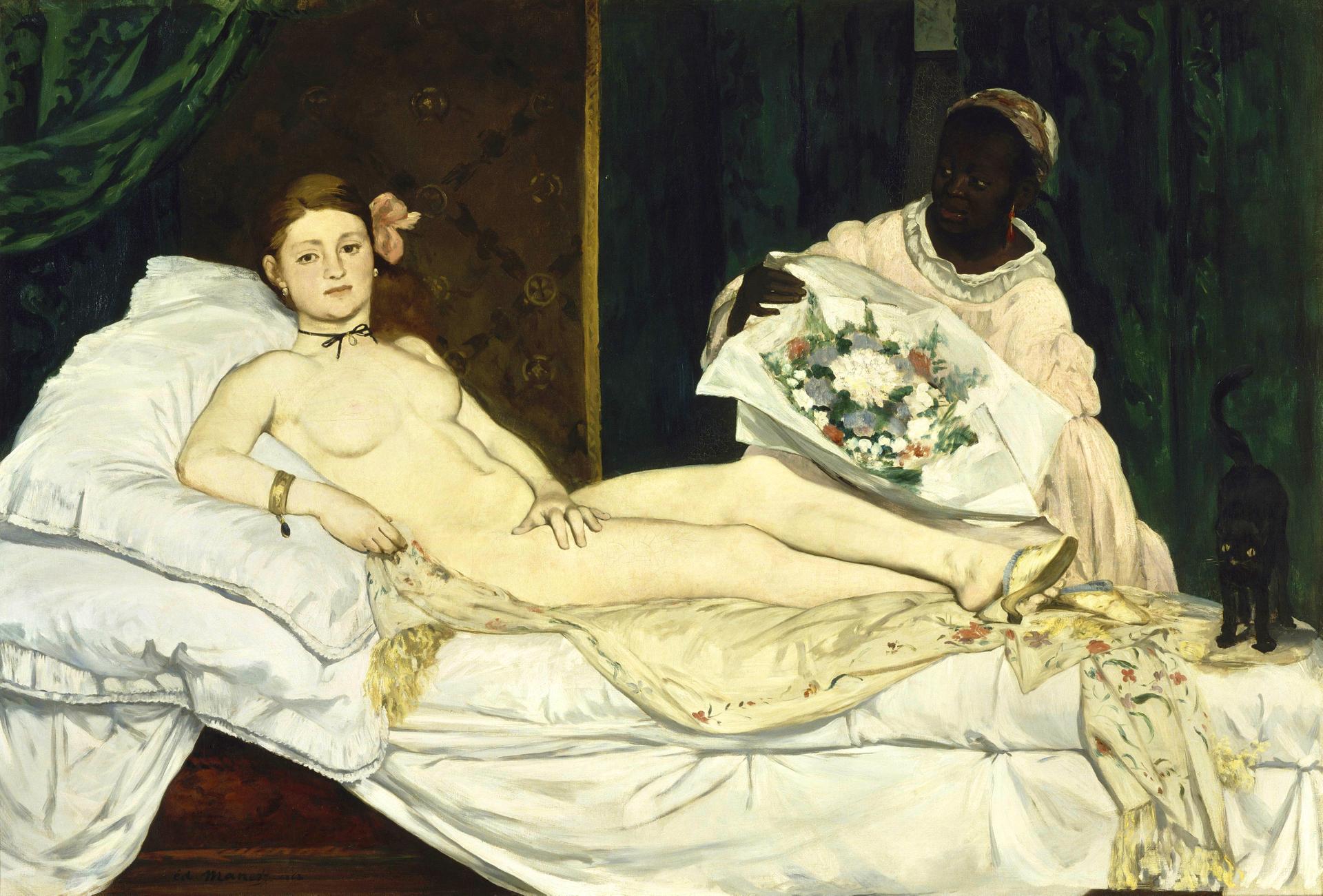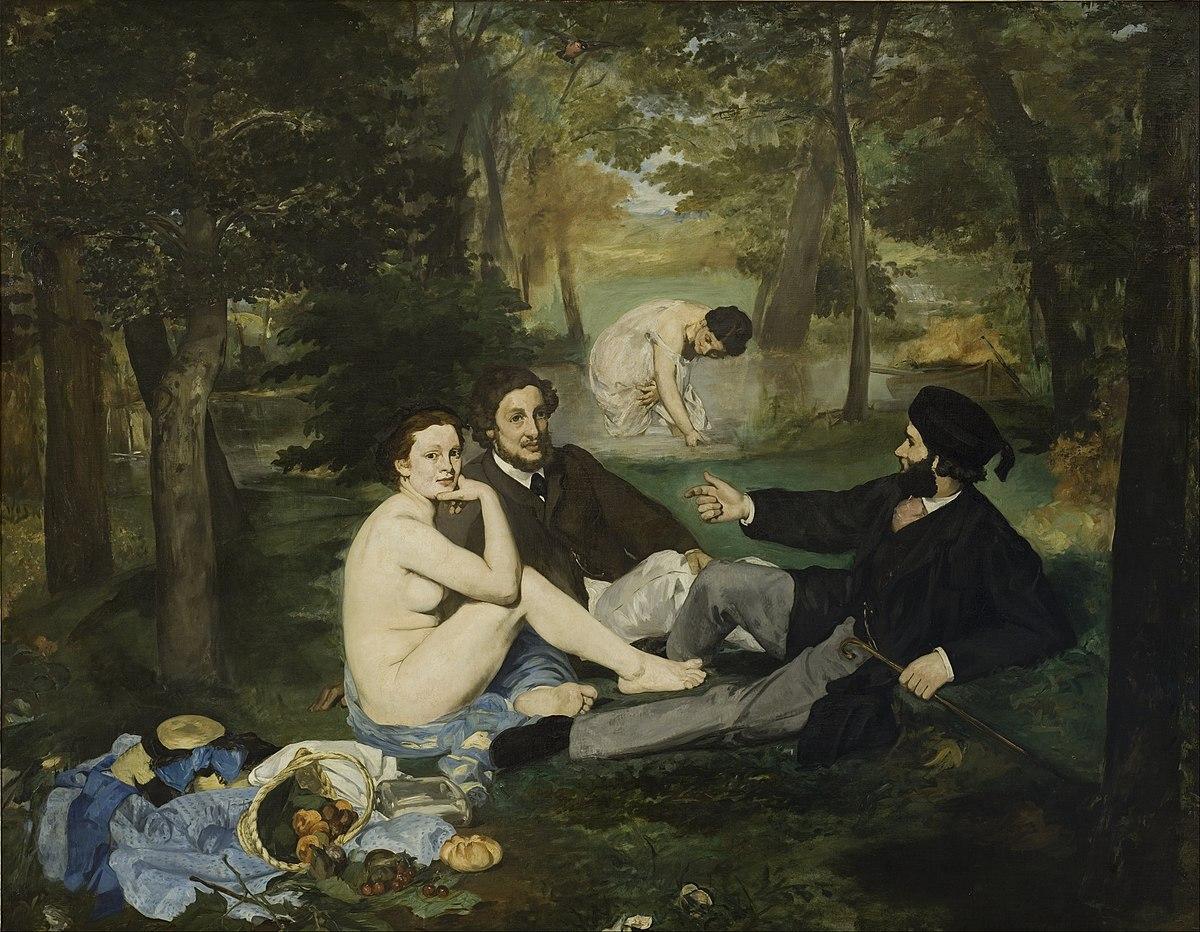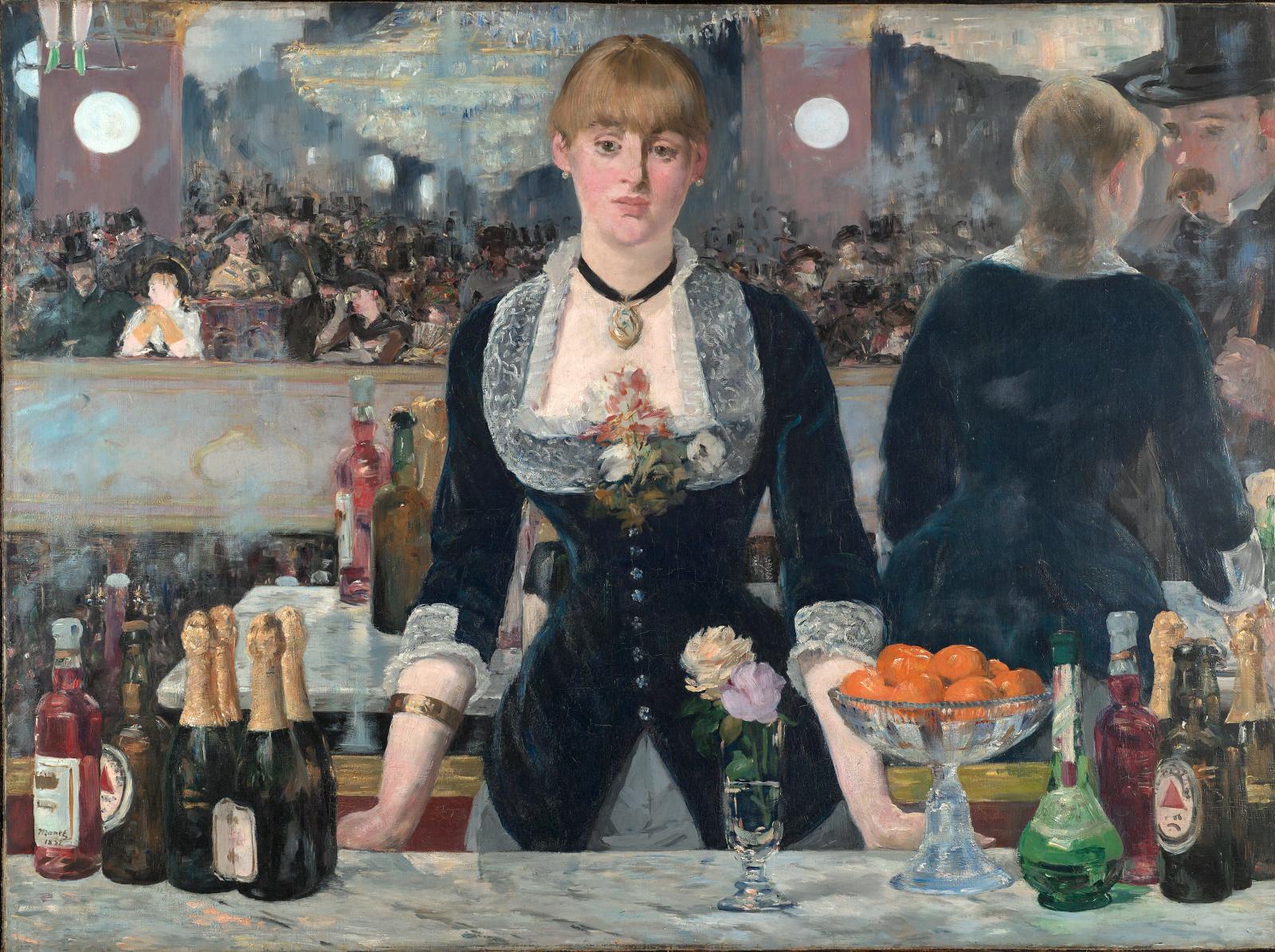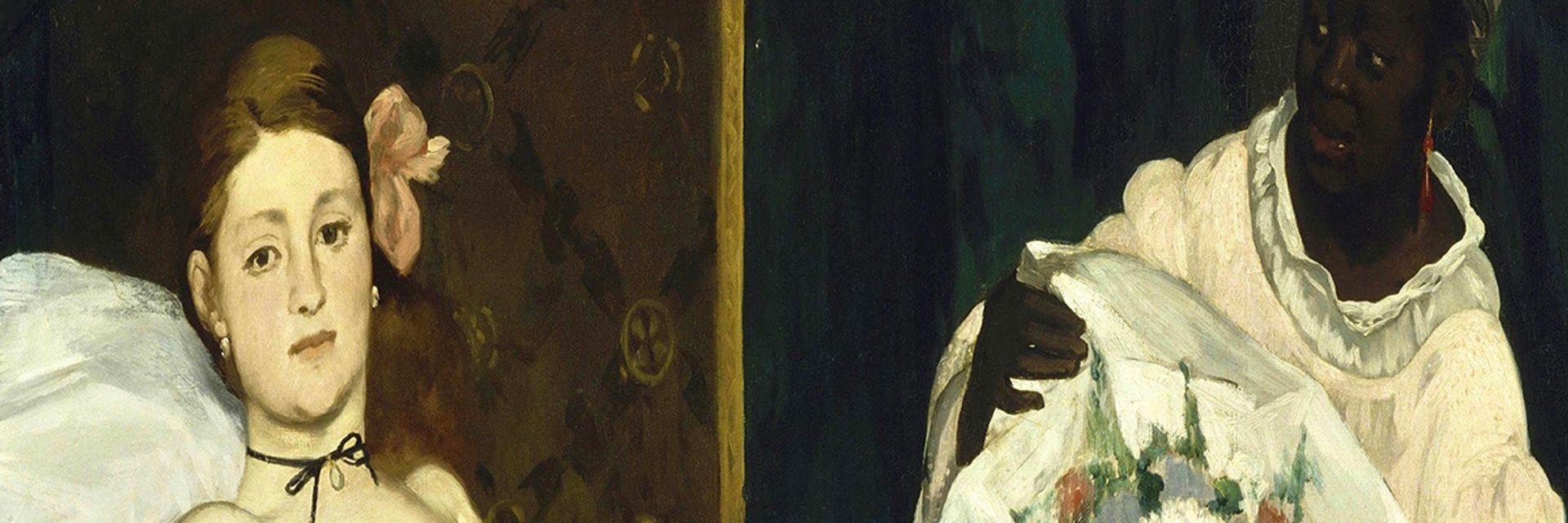Édouard Manet was, in several key ways, the first truly “modern” painter. Born in Paris at a time of great social upheaval, he replaced traditional history painting with views of contemporary urban life. Manet also revolutionized the depiction of relationships in the contemporary scene, confronting viewers with the gaze of his insouciant subjects.
◊
At first glance you’re captured, and you can’t look away. Her eyes, her face, that steady gaze is enticing, if slightly unnerving. You notice she is coolly regarding you, just as your gaze is upon her. Moreover, she’s naked, shielding her privates with the most casually draped arm. And her skin, painted in oils that cast a pale pallor, displays an almost ghostly whiteness – this is skin that has rarely, if ever, felt the warmth of sunrays. Clearly, this is no classical goddess.

Olympia, 1863, in the collection of the Musée D’Orsay, Paris. (Image Credit: Google Arts & Culture)
Yet, Édouard Manet gave his 1863 painting of model Victorine Meurent a classical name: Olympia. Manet painted Meurent as a courtesan receiving a lavish floral bouquet (perhaps from an appreciative client?) handed to her by a maidservant of African descent (portrayed by another model known only as Laure) while a black cat arches its back in the lower right corner of the composition. Meurent’s unemotional gaze, aimed directly at the painting’s spectator, as if caught by the recently invented long-exposure camera, was disturbing, and it confounded its viewers when the painting was first exhibited at the 1865 Paris Salon.
Conservative art critics considered the shocking work an affront to spectators accustomed to seeing sedate paintings of historical subjects and formal portraits at the annual Salon. But Manet’s supporters, including such Parisian literary lights as Emile Zola, Stephane Mallarmé, and Charles Baudelaire, praised the artist for being a painter of the contemporary moment, capturing “the transient, the fleeting, the contingent.” Manet was happy for the attention; coming from a wealthy, middle-class family, he always felt his paintings deserved to be selected for the official Salon.
Manet, the Sharp Observer of an Emerging Modernity
In the mid-19th century, Paris underwent a grand upheaval as the city was redesigned under the order of France’s emperor Napoleon III. Architect and planner Baron Georges Haussmann created wide boulevards and breathtaking open urban vistas, capturing a feeling of excitement as the pace of city life quickened. A new social class of free-wheeling strollers, or flâneurs, took to these freshly laid thoroughfares, and they populated the rich social life of the proto-modern Parisian environment.
As a well-heeled young man, Manet participated in the revitalized city’s novel nocturnal delights with gusto. He and his male friends (“respectable” women did not take part in such scenes) frequented the bars, cafés, folies, and opera houses that now flourished in metropolitan Paris. Manet and his fellow flanêurs enjoyed their new roles as night-time observers, taking in the sights, sounds, libations, and other enjoyments as the evenings passed.
This new custom of social soirées in the evenings and lounging during the days was a particularly modern trait of this era. City dwellers of privileged classes could now enjoy a lifestyle not proscribed by the need to work for a living. For some, like Manet, the link between life and manual labor was completely severed. He and his artist friends flocked to their favorite boîtes, to see, to be seen, and to absorb the culture of jouissance, the ongoing search for joy and all it entails.
Manet, the First Truly Modern Painter
Manet had received academic training from several established Parisian artists, primarily Thomas Couture, in the accepted style of the day, a kind of romanticized realism that borrowed liberally from Classical and historical subjects. He was trained to work on a large scale and to address themes drawn from mythology and history. Those were the forms of art most appreciated by the academic tastemakers of the day, and by the jurors of the Academie des Beaux-Arts who selected new work for each year’s Salon.
Manet was able to travel extensively as a young student of art, being especially interested in Flemish and German art, and in the work of Spanish painters including Velázquez and Goya, known for their use of light and shadow.
But Manet wanted more. He was determined to explore new subjects, savoring the exciting contemporary life he experienced with his other artistic friends. He was intent on using his skills not to reflect the conventional trends in art, but to create exciting paintings “of the moment” that reflected his personal vision of the new Paris. To accomplish this, he became, in essence, the first truly “modern” painter.
He used the skills and techniques he had learned at the academy to develop an art rooted in accepted styles from the recent past, but which presented subjects freshly drawn from his everyday life and experience. The notorious Olympia’s composition borrowed liberally from celebrated artworks of earlier times, particularly the Renaissance painter Titian’s Venus. The unavoidable difference? This “Olympia” had obviously not descended from the heavens.

Le Déjeuner sur l’herbe, 1863, in the collection of the Musée D’Orsay, Paris. (Image Credit: Google Arts & Culture)
Manet – and His Model – Shock the Bourgeoisie
Olympia was not Victorine Meurent’s first appearance in a Manet painting. In fact, she was featured, both clothed and nude, in numerous of his works. Perhaps her most notable appearance was in his 1863 masterwork Le Déjeuner sur l’herbe, or Luncheon on the Grass. In this tableau of four figures arrayed in a natural setting, two, the men (shall we call them flâneurs?), are relaxed and fully clothed. One woman appears to be washing up casually in a small stream in the background, and the other woman, Victorine, is again totally nude and staring out of the picture frame – and, again, directly at the spectator. Once more, we viewers are caught in a two-way gaze with a “painted lady.”
The reception to this painting was even more raucous than that accorded to Olympia. Although it, too, was based on previous artworks – paintings that featured goddesses, nymphs, and sprites – the selection committee for the 1863 Salon balked. They were scandalized by this scene. Apparently drawn from someone’s lived – or imagined? – experience, the subject ran so counter to the committee’s expectations of the fine art of painting – not to mention their sense of moral outrage – that the incensed jurors refused the painting.
In fact, so many contemporary works were refused that year that rejected artists appealed to the government to establish a separate Salon for their work: the Salon des Refusés. Manet, indignant to be among the rejected, agreed to have Déjeuner shown at the alternate exhibition. Even there, it was so controversial that it had to be placed behind a cordon to shield it from viewers who, aroused by anger or other emotions, may have wanted to damage the painting.
The work was widely condemned for its “immoral” subject matter as well as for its loose, seemingly unfinished brush strokes in parts of the work. But, again, Manet’s compatriots in the artist community rallied around him. Author Émile Zola referred to it as a masterpiece, his “greatest work,” and called the painting, “one in which he realizes the dream of all painters: to place figures of natural grandeur in a landscape.”
Manet and His Circle: The Birth of the Impressionists
Over the succeeding years, Manet’s star continued to ascend, fueled by celebrity as well as notoriety. His influence grew, and he gathered around him a circle of younger artists who were influenced by his style and his very contemporary subject matter.
These artists, who came to be known as the Impressionists, often exhibited together, yet Manet consistently declined to show with them. Although he was close with many Impressionists, especially his good friend Claude Monet, he perceived enough differences between his and their work that he resisted being called an Impressionist at all. Still, perhaps it is fair to say that Manet was a father to the artistic movement.
Although Manet was not known as a teacher (frankly, he didn’t need the money), he did consent to mentor one artist, notably a woman, the Impressionist Eva Gonzalès.
Among several crucial differences between Manet and the Impressionists is that he rarely painted outdoors, preferring to work in a typical studio setting. In addition, all the Impressionists pledged to avoid using the color black in their paintings, preferring to capture light effects using solely the colors of the spectrum. Manet used black oil paint masterfully, defining background space as well as the fabric of fashionable black clothing in detail.
Technological innovations of the era also contributed to the distinctly modern look of the art. Recent advances in railway travel allowed city-dwellers to visit the lightly populated countryside, inspiring not only Manet’s (and the Impressionists’) interest in railway stations but allowing city painters to pack up their paints and head out to the country to soak up inspiration along with the sunshine. Even Manet went off into the country to visit Monet and his family, resulting in a handful of paintings done in the modish plein-air style.

Un bar aux Folies Bergère, 1882, in the collection of the Courtauld Gallery, London.
(Image Credit: Courtauld Gallery)
The Mirror of Modernity: Manet’s Bar at the Folies-Bergére
Manet continued his examination of social mores through the remainder of his career. He closely examined the relationships of his contemporary Parisian society with images of casual gatherings and more formal arrangements of men and women in both domestic and convivial settings.
Perhaps Manet’s most important late work is Un Bar aux Folies Bergère, or A Bar at the Folies-Bergére. Painted in 1882 (and a highlight of that year’s Paris Salon), the work depicts another young woman of the working class, this time a fully clothed barmaid whose psychologically complex yet ambiguous gaze completes a powerful scene combining intimacy, isolation, and class relations. The barmaid (an actual Folies employee named Suzón) is framed centrally, standing in front of what seems to be a huge, impossibly close mirror that reflects everything but the artist. She wears an expression that one could read as disinterest, weariness, even as subtle rebelliousness against her servile situation.
In the mirror is a complex mass of activity from which Suzón seems to stand entirely separate. In the upper left corner of the composition, almost completely cropped out as if in a casual photographic snapshot, is what should be the central focus of attention: an acrobat balancing on a flying trapeze well above the spectators’ heads. But even the bar patrons, rapidly sketched in on the left side of the mirror reflection, seem only desultorily interested. One seems to be using a set of opera glasses, while others appear to talk or to be distracted by other matters.
To achieve Manet’s mix of the transitory and the permanent, he began with quick sketches onsite, then developed his paintings through modeling sessions in his studio for the primary characters of each work.
A somewhat mysterious man looms at the right edge of the painting, reflected in the mirror. One might think at first glance that it’s a portrait of the artist, a little visual trick of artistic placement. However, a bit of research reveals that the figure depicted in the corner of the frame is not Manet, but a friend of his. Suzón’s reflection in the mirror is apparently bent toward the man, who carries a walking stick and whose attentions are consumed by the barmaid.
Nonetheless, the Suzón we see is disengaged. Her sight seems to be set in the middle ground, rather than close up. Is she “looking through” her customer and his nocturnal desires? One thing is clear: She is a woman with agency, and it’s an agency observed by and accorded to her by the artist. More than merely a photographic capture of an instant in time, this artist’s model – much like Victorine Meurent – is sharing her own, independent view of the overall scene from the surface of the canvas.
The Three “Gazes” of Modernity: Artist, Model, Spectator
This is another notable marker of Manet’s “modernity.” In Un Bar aux Folies Bergère, even more than Olympia and Déjeuner, the viewer has several “gazes” to contend with. We’ve seen Suzón’s ambivalent gaze. She’s apparently received her customer’s request, and we’re left to wonder, as she considers it, whether she will consent or not.
The customer – a stand-in for the questioning viewer – also has a gaze, which is clearly on the barmaid. This may be seen as an objectifying gaze, the “male gaze,” through which his power and even his sexuality are potentially felt. With his imperious, protuberant stick, he may be establishing his social class in the situation. He could even be propositioning the maid.
Thirdly, there is the gaze of the artist, Manet, who has added clues to sexualize the waitress (the bowl of oranges can symbolize sex as a currency), yet who stands completely outside the composition. (Perhaps he stood to the left of the patron and his cane, and just beyond the border of the painting.) It’s the artist who breathes life, and intrigue, into this monumental work, and it’s his own modern world, captured by his gaze, into which we're invited.
Manet, then, was not only a “modern” artist (predating Modernist painting by a generation or two), he was also well ahead of his time in the humanist project of giving agency to populations that have been objectified. This includes women in general, people of the working class, and underrepresented, “exoticized” races, such as the maidservant of Olympia. If you felt an identification or empathy with the roles of these depicted women, Manet was successful in the work of bringing them to life.
Ω
Kevin Martin is Senior Writer for MagellanTV. He writes on a wide variety of topics, including outer space, the fine arts, and modern history. He has had a long career as a journalist and communications specialist with both nonprofit and for-profit organizations. He resides in Glendale, California.

